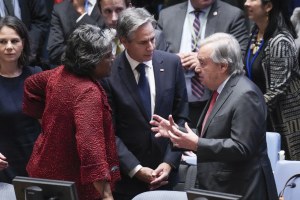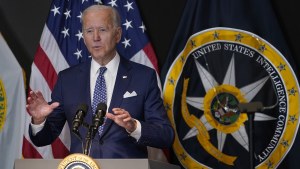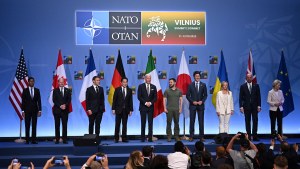How Partisan is US Foreign Policy?
 Play Podcast
Play Podcast
About the Episode
Deep Dish explores how America’s hyper partisan politics are impacting foreign policy actions. Author Jordan Tama shares revelations from his new book, while the Council’s Dina Smeltz unveils fresh survey data to expose how partisanship plays out in US foreign policy.
- Bipartisanship and US Foreign Policy: Cooperation in a Polarized Age, Jordan Tama, Oxford University Press, September 1, 2023
- Public Opinion Survey Reports, Chicago Council on Global Affairs
[Lizzy Shackelford: INTRO: This is Deep Dish on Global Affairs— going beyond the headlines on critical global issues. I’m your host, Lizzy Shackelford with the Chicago Council on Global Affairs.
Today, we have a power-packed episode lined up for you as we unravel how partisanship plays out in US foreign policy. Joining us are two exceptional experts: American University’s Jordan Tama, and author of the new thought-provoking book "Bipartisanship and US Foreign Policy." And we have Dina Smeltz, The Chicago Council’s senior fellow, bringing fresh data from the recent Chicago Council public opinion survey. As Jordan walks us through the findings of his new book, offering deep insights into bipartisan dynamics, Dina will share eye-opening results from the survey, revealing how international events are shaping public opinion here in America.
The premise of his book, which I read and find fascinating, is that even in today's hyper partisan political landscape, foreign policy remains a space where bipartisanship happens. Jordan says that he came to that conclusion 10 years ago, when he worked in Congress on human rights issues for a democratic member of Congress, Jim McGovern...]
Jordan Tama: I saw that he was able to create a bipartisan coalition around legislation to put sanctions on Russian government officials who've committed human rights violations, and I thought, huh, that's interesting, does bipartisanship also happen on other foreign policy issues, and so I studied lots of different foreign policy issues, and I found that there are quite a few areas of foreign policy, but where bipartisanship occurs regularly. That's not to say that bipartisanship always happens on foreign policy. There are a lot of foreign policy debates that are very polarized these days, but the political landscape really varies from issue to issue. So, we tend in the United States to think that everything is polarized. That's not true. Even as our overall political environment has gotten more polarized, there are still certain issues where Democrats and Republicans will work together. Doesn't always mean they're totally unified across, the two parties, but there are often some Democrats and some Republicans working together on many foreign policy issues.
Lizzy Shackelford: And why is bipartisanship in the foreign policy space so important?
Jordan Tama: Well, it's really important because it influences America's ability to act effectively on the global stage. One of the areas where this is most important is the ability of the United States to be a reliable partner to actors overseas. So, when we have one president who makes international commitments, signs onto some international treaties, and then the president's successor pulls out of those agreements, which happened when Trump replaced Obama, pulled out of the Iran nuclear deal, pulled out of the Paris Climate Accord, exited the Trans Pacific Partnership, that sends a really bad signal to our partners overseas who think, well, why should I cooperate with the United States, make any concessions to the United States if a new president is going to come into office in a couple of years and pull out of that agreement and similarly with Congress, if the president as Biden is doing today is making public commitments to the long term security of Ukraine, but he can't convince Republicans in Congress to provide aid to Ukraine that weakens the standing of the United States overseas because it makes it look like we can't live up to our commitments.
Lizzy Shackelford: Now, Jordan's book is looking at what's happening in Congress and in the government. The Chicago Council survey is looking from a very different perspective. It's assessing how this looks from the public perspective. Dina, can you tell our listeners a little bit about the survey and how it's been used? It's been almost 50 years, that they've been running the survey, right?
Dina Smeltz: Yes, exactly. The survey came about because one Henry Kissinger was very interested to learn whether the Vietnam Syndrome had set in among Americans in the 70s. And found funding for us from the Ford Foundation. So, we thank Henry Kissinger for that. So, we've been conducting these surveys among the American public for, yeah, five decades now. Really, it's important to look at public opinion because it keeps our Policymakers accountable, in a place where foreign policy usually is not something that American people focus on very much themselves. They have other things to worry about on a day-to-day basis. So, they sort of outsource the decisions and have confidence in political leaders. So, this is some way to gauge, whether the public and the leader decisions are in sync. And this year's survey shows, in some ways there's some enduring bipartisanship in the fact that most Americans, whether you're Republican, Democrat, still support alliances, still support bases overseas, maybe not to the same extent as they did in the past, and we can get into why, but they still support free trade and international agreements. But there have been some more partisan gaps in the recent survey, and a lot of that is due to the effects of the war on Ukraine on people's perceptions of the cost of US international involvement.
Lizzy Shackelford: There are definitely a couple of more hot button issues where you see that bigger partisan split in public perceptions. What are a couple of examples of those?
Dina Smeltz: Well, Immigration in the 1998 surveys and like the early years, Republicans and Democrats were equally concerned. What has happened over time is that Republicans have stayed pretty highly concerned. It's one of their top threats in each of our surveys. while Democrats have become less and less and less concerned about immigration and don't see it as a critical threat. The opposite is true for climate change. Again, Democrats have become more and more concerned about it. Republicans have stayed minimally concerned. Consistently over time, and that's created actually one of the largest gaps we've ever seen in this year's survey. So, there's some that are more recent. The primary one, in terms of immediacy is the support for continued funding for Ukraine. Support is still pretty solid. The 6 and 10 Americans still support continuing economic assistance and financial assistance, and giving military arms to Ukraine, but there's much bigger gaps between Republicans and Democrats now. For Republicans, 47 percent say that the United States should continue providing economic assistance to Ukraine compared to 76 percent of Democrats. It's a really large difference, and same among, sending additional arms and military supplies to the Ukrainian government, it's 50 percent of Republicans versus 77 percent of Democrats. So, this goes directly to what Jordan was kind of discussing earlier about the Republican leadership now raising questions around supporting Ukraine at the beginning of the conflict in our survey in March 2022, eight and ten Republicans and Democrats supported giving arms to Ukraine. So, it's really the Republicans that have fallen off and this is one example of where what's going on in Congress and in the media debates. Depending on what media you listen to, can really affect public opinion.
Jordan Tama: Yeah, I think the very vocal opposition to aiding Ukraine from Donald Trump, Tucker Carlson, and some of the other kind of prominent MAGA Republicans in Congress, like Marjorie Taylor Greene, Matt Gaetz, these, prominent voices influence how Republican voters, especially the MAGA voters think about issues. And what's striking now is that just as Dina has highlighted how the Republican electorate is rather split over aid to Ukraine, right? About half of Republican voters are supporting aid to Ukraine and half are against. There's also a similar split in Congress among Republican members of Congress. So, many of the kind of loudest Republican voices in Congress are anti aid to Ukraine, the MAGA Republicans, but there are also other Republicans, Mitch McConnell, Lindsey Graham, in the House, Michael McCaul, the chair of the House Foreign Affairs Committee, who are very pro Ukraine, and they want to continue aid to Ukraine, so this is one of the issues where there's a real division within the Republican Party, and it's really, really reflects a broader debate within the Republican Party over the party's future on foreign policy, whether to follow the America first, direction of Donald Trump, or stay more wedded to the kind of Reaganite, hawkish internationalism that was the mainstream of Republican, foreign policy thinking for many decades.
Dina Smeltz: Also, like this is the first time in our survey that we have ever seen a narrow majority of Republicans saying that the United States should stay out of world affairs rather than, have an active part in world affairs. 47 percent of Republicans say we should have an active part versus 53 percent say stay out. So, that is the lowest we've ever seen for Republicans. And it's pretty striking when you look at the trend over time, because Republicans had generally been more likely to say the United States should take an active part in world affairs by high majorities until 2014, when Russia invaded Ukraine, which then prompted all kinds of questions that became domestic issues in the United States because of Russian interference in the US elections. So that's when we started to see some declines in Republican support for an active world affairs, but it has steadily declined. And it's now it's the lowest point
Lizzy Shackelford: Well, it's, hard not to focus a lot on the Trump effect really. But Jordan, I'm curious if there are periods prior to that that have shown a real impact on partisanship in foreign policy. I mean, you've been tracking the congressional voting records for a long time. What are some other moments that really stand out?
Jordan Tama: Well, the Cold War is often held up as the era of maximum bipartisanship, and to a large extent, that's true. There was often a high degree of bipartisanship during the Cold War, but people tend to forget that even during the Cold War, were some very intense partisan fights. When the communists, took control of China in 1949, Republicans in Congress were all over Harry Truman for, quote, losing China. And there was hearings where, you know, McCarthy and other Republicans in Congress were going after Truman administration officials, charging them with being communist. So, even that era was not always bipartisan, but that was a high point of bipartisanship. After 9/11 was another high point of bipartisanship, the, phenomenon of people rallying around the flag, following the 9/11 attacks emerged a lot of partisanship, around the Iraq war as that war moved forward and became a disaster. Most Democrats became strongly opposed to the Iraq war. Republicans for quite a while were, proponents of the war, defenders of the war. So, partisanship was strong in debates over the Iraq war and partisanship has marked other, you know, particular debate. So, when Barack Obama negotiated the Iran nuclear deal in 2015, the joint comprehensive plan of action under which the US lifted economic sanctions on Iran in return for Iran accepting constraints on its nuclear program, every Republican member of Congress and every Republican presidential candidate in 2016 opposed that agreement. Almost every Democrat supported it. And there has remained a significant divide over diplomacy with Iran, in the years since then. And that's an issue where Democrats tend to be more open to diplomacy with adversaries, multilateralism, and that's reflected in that issue.
Lizzy Shackelford: And do we see the partisan differences and the bipartisan topics -- do those track fairly closely between what we're seeing in Congress and what we're seeing in the public? I mean, I know you're both looking at these separate issues, but it sounds as though a lot of those topics tend to track fairly closely between what congressional leadership is, how they're approaching it in the public opinion.
Jordan Tama: I think they do tend to track well, because of influence actually going in both directions. I mean, public takes its cues from elites. And so, when members of Congress are taking certain positions that influences the positions of voters, we've seen that with Ukraine, where, really the statements of Trump and other MAGA Republicans, who are opposed to aiding Ukraine have moved Republican voters in a more anti Ukraine direction. But also, politicians take cues from voters, especially on high salience issues. So, this tends to be mostly the case when it comes to issues like military intervention that the public really cares about. When, you know, US leaders were considering intervening in Syria during the civil war in Syria. After the Arab spring, there were a lot of debates in the Obama administration about whether to intervene. It was clear that the American public did not want the United States to intervene in Syria and that was significant in making Barack Obama and other political leaders more reluctant to intervene because they knew that it would be hard to have the public with them on an issue like that. So, when the public really cares about something, then they can influence the views of elected officials. But often the influence is going the other direction.
Dina Smeltz: I think you're right, and especially when the media amplifies certain, positions that politicians take. But sometimes it does come from the ground up. And I do think it's a back and forth of our hypothetical questions about, would you be willing to support X or Y? Then when they become a reality, the policymakers know what the sort of receptivity to an initiative will be, then the public reacts to it, then the policymakers respond, maybe try to message so that they can convince the public one way or the other, but they also take into account what the public thinks. So, it's more of an interactive, relationship once an issue is live. And I think what another interesting thing is, Adam Berinsky wrote in the Time of War, that public attitudes can be influenced directly by dramatic events. And we certainly saw that, the bipartisan support after September 11th, and then he mentions like the Pearl Harbor attack, but he said is primarily structured by the ebb and flow of partisan and group based political conflict which I think is really interesting because really the partisan politics plays a greater role for everyday foreign policy among the public.
Jordan Tama: I think the Israel case is interesting and that's, you know, evolving since the war between Israel and Hamas is only a few weeks old now. But I think there are already signs that the views and activism of some progressive Democrats may be having some influence on what some Democratic elected officials are saying in the sense that initially the response to Hamas' attack on Israel among, elected officials was almost entirely strongly pro-Israel. There were very few Democrats who were expressing any, you know, criticism of Israel. In recent weeks there's been progressive activism that is more critical of Israel calling for a ceasefire and you've seen more democratic politicians sort of making similar calls. And so I think that's an issue where the politicians are kind of keeping tabs on what their constituents are saying and doing the other thing I was going to add is, you know, we tend to talk about public opinion as an aggregate, but often it matters sort of like, what does The subset of voters who really care about this issue think, and that's something we see on trade. Whereas Dina mentioned, you know, the Chicago Council surveys have, consistently shown that most Americans are, positive with regard to free trade. They favor free trade, and yet we often see politicians pursuing more protectionist trade policies, and often what's going on there is that most Americans are pro trade but don't really care that much about trade, but there's a subset of voters who are passionate about it and they tend to have more protectionist views and that's often the traditional kind of manufacturing, blue collar type voter. We imagine, the auto workers and others in industries that are threatened by foreign competition, and then politicians will respond to that. And as a result, politicians are often more protectionist in their stances on trade than the aggregate public would suggest.
Lizzy Shackelford: How do different opinions in kind of the subset that's very vocal versus the American public more broadly, how do they interact in Washington? I mean, is there a way that just broad public opinion can really push the needle as much as special dedicated interests can?
Jordan Tama: I think that these things are often difficult and entirely disentangle, but I think on most issues broad public opinion is not shaping what the politicians do, because on most issues, the public is not really engaged enough. The public is not going to vote on that issue. And so, then it's more question of what our interest groups arguing. Which I would actually use the term interest groups broadly to describe all kinds of advocacy groups, which is not only business interests. It's not only, you know, ethnic communities or diaspora communities. It includes NGOs, grassroots organizations. There are all kinds of organizations that advocate on foreign policy from all different perspectives. And many of those groups are influential on particular issues. But then when an issue kind of rises in public salience, then I think broader public's views matter. But most issues just don't rise to that broader level.
Lizzy Shackelford: One issue that I'm really interested in today is that there's a faction within the Republican Party that views any kind of compromise with Democrats as being weakness or failure somehow. What are the implications of that approach on our foreign policy decisions? And Jordan, I'm really curious, are there any historical precedents for kind of this type of attitude, on either side of the aisle?
Jordan Tama: Well, there have been previous periods in American history where polarization was extremely high, you think of the civil war era. Polarization now, by some measures is the highest it's been since the civil war era. But there have been, intensely partisan debates on particular issues throughout American history, the debate of the League of Nations, Woodrow Wilson's idea to have this international organization to protect peace after World War One, sent that proposal to the Senate as part of the Treaty of Versailles, the debate in the Senate was highly polarized. It was, mainly, prominent Republicans who opposed that idea to have the US enter the League of Nations, and they were able to vote it down. And that was largely a debate about how much should the United States get involved internationally or whether it should maintain its independence from international commitments. So, in the kind of broad sweep of history, there have been ebbs and flows, periods of bipartisanship, periods of polarization and also just kind of variation across the issues. In the 1930, there was a strong America first movement in the United States. That's actually where the term America first came from. Don't know if Trump knew about that when he started using the term, but there were real isolationists who were very prominent in American politics and pushed for isolationist legislation designed to keep the US out of World War Two before World War Two was really, you know, happening and FDR had to kind of gradually push back against that to get the United States willing to engage in World War Two. So, the point I'm trying to make is just that there, have been major foreign policy debates before. I think what's different today is the intensity of the partisanship and the extent to which on so many issues, politicians are trying to score political points rather than really, taking seriously the substance of the issue and the level of vitriol, I think, is also greater than it used to be. And I think social media has contributed to that. People are communicating, politicians are communicating to their base, through media outlets that facilitate or enable partisanship in a way we didn't have before when people were communicating to the broader public rather than to these kind of base communities.
Dina Smeltz: Jordan, you point out in your book that opinions of President Biden in his first year, the gap between Republicans and Democrats on his approval ratings was the highest it's ever been of any president in their first year. And it's really interesting because in our survey, when we ask about what are the top threats to the United States national security, both Republicans and Democrats list in their top five, weakening democracy and political polarization. But we know they each blame the other side for being the problem. But I think the kind of poisoned atmosphere among partisans, among the public certainly doesn't help.
Jordan Tama: And one of the most, I think, striking and distressing data points I've seen is that most Democrats and Republicans don't even like each other, on just on a personal level. I'm not talking about politicians, but just ordinary people. Like, there are these questions that have been asked by Pew, that asked people to rate how they feel about members of the other party on a scale of 0 to 100. These are called thermometer scales, where 100 is a very warm feeling and 0 is a very cold feeling. And the average American now feels toward people in the other party something like 20 which is very cool feeling. So, most people, have strong biases and ill will toward people in the other party. That's very troubling.
Lizzy Shackelford: We started at the top of the hour discussing how there's still bipartisanship out there. So, it's not as dire as it sounds, but as we conclude the conversation, what should our government leaders do with the understanding that we are losing some of that bipartisan agreement on kind of how we engage with the world?
Jordan Tama: Well, I would point to two things. One, I would say our leaders need to spend time with people in the other party. There's a socialization aspect of this where members of Congress used to socialize with each other across party lines. They actually knew each other and were often friends, even if they're from different parties. That doesn't happen so much anymore. And our political system is worse as a result of that. And so, for all Americans, studies have shown that when you interact with people, get to know people who are different from you politically, that helps broaden your perspective. A more specific thing I would suggest is that politicians, policymakers should recognize that even in our polarized environment, there are issues where you can work with people on the other side, and you should seek those out and be open to those opportunities. If you're a Democrat, don't assume that there are no Republicans who could work with you on this issue or vice versa. Because there are quite a lot of foreign policy issues where there can be coalitions that span the two parties.
Lizzy Shackelford: Jordan Tama of the American University and Dina Smeltz of the Chicago Council -- I want to thank you so much for being here on Deep Dish to help us bring bipartisanship and US foreign policy in focus. And I really appreciate the work that you have both done to make it a lot easier for us to get a glimpse of how this is playing out in Washington and in the streets of America. Thank you so much for being here!
Jordan Tama: It was a real pleasure to talk with both of you.
Dina Smeltz: Thank you for inviting us, Lizzy.
[Lizzy Shackelford: OUTRO: And thank you for tuning in to this episode of Deep Dish!
A reminder that we want to hear more from you, our listeners. So, send us an email or, better yet, a voice memo, to deepdish@globalaffairs.org -- You can suggest issues you’d like us to cover, guests you’d love to hear from, or you can just let us know how you think we’re doing.
And if you are looking for more Deep Dish in your podcast diet? Tap the “follow” button in your podcast app so you get each new episode as it’s released. If you think you know someone who would like today's episode, please "share" it with them!
As a reminder, the opinions you heard belong to the people who expressed them and not the Chicago Council on Global Affairs. This episode is produced and edited by Kyra Dahring and mixed by Frank McKearn from Aphorism Productions.
Thank you for listening. I’m Lizzy Shackelford and we’ll be back next week with another slice of Deep Dish.]






Related Content
 Public Opinion
Public Opinion
Biden-era surveys affirm continued support for the intelligence community but also signal growing partisanship.
 Public Opinion
Public Opinion
As the war in Ukraine continues, majorities say the United States should maintain or increase its commitment to NATO.
 Public Opinion
Public Opinion
Poll finds a majority of Americans value the US security partnership with Israel but say the status quo between Israel and Palestinians is unacceptable.
 Public Opinion
Public Opinion
While the US public believes trade is good for the economy, it does favors some restrictions—especially on goods such as semiconductors.